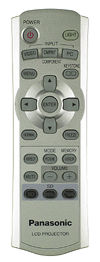Panasonic PT-L300U LCD Projector Page 2
 I say "near-black" because solid-state projectors can't produce the truest black (the absence of light) as well as a CRT-based machine. The PT-L300U also fell short of the black-level performance of the latest black-matrix DLP projectors, but it was still better than any of the three LCD projectors I've previously used at home. Inadequate black level is most bothersome when dark areas seem to detach themselves from the rest of the image, turning into gray blotches—like a bad paint-by-numbers painting. The PT-L300U's black-level performance was just good enough to avoid emphasizing this effect. In the dark, with my room's 13-foot throw distance, there was brightness to spare. The manual's spec list rates the projector's luminosity (I like that word) at 800 ANSI lumens.
I say "near-black" because solid-state projectors can't produce the truest black (the absence of light) as well as a CRT-based machine. The PT-L300U also fell short of the black-level performance of the latest black-matrix DLP projectors, but it was still better than any of the three LCD projectors I've previously used at home. Inadequate black level is most bothersome when dark areas seem to detach themselves from the rest of the image, turning into gray blotches—like a bad paint-by-numbers painting. The PT-L300U's black-level performance was just good enough to avoid emphasizing this effect. In the dark, with my room's 13-foot throw distance, there was brightness to spare. The manual's spec list rates the projector's luminosity (I like that word) at 800 ANSI lumens.
The literary passions of The Hours didn't splash against the screen until after dark. That was when the PT-L300U really strutted its stuff. Glimpses of lush English countryside had the same highly saturated green I saw this past spring in the northeastern U.S. (nourished by perpetual rain that kept everyone griping). As I fixated on strands of hair, I was reminded that this wasn't HDTV, but then I'd be stirred by the shifting networks of facial lines in close-ups of weary characters, especially those played by Meryl Streep and Ed Harris.
The screen-door effect—when pixels are so large and well-defined that they're visible—was a total non-issue. Panasonic uses what they call a double refraction crystal, an optical-manipulation device that's placed between the liquid crystal panel and the lens to reduce the dark borders between pixels. At anything resembling a normal viewing distance, the pixel grid essentially disappears to form a smooth picture. You have to walk up to the screen to see the pixels. For anyone who remembers the first few generations of consumer-level LCD projectors—with their lower pixel density, less-sophisticated optical processing, and sky-high LCD-panel defect rates (and pricing)—this Panasonic seems nothing short of miraculous.
The next day, I got curious about video artifacts and ran the part of the Sage/Faroudja test disc that shows an American flag waving in the wind. When given an interlaced signal, the projector did a good (although not perfect) job of smoothing out the jaggies. In another sequence that shows rapidly moving diagonals (hockey sticks and a quick pan over the top of a Plexiglas barrier), the hockey sticks came through perfectly, while the barrier showed a modest amount of stair-stepping.
I continued my jaggie hunt with the high-def reels that WNET-13 runs during the day in New York. As the projector downconverted 1080i HDTV to its own native resolution of 960 by 540, finely spaced, near-horizontal lines shimmered at certain times. This didn't happen all of the time (the scaler aced a shirt with fine horizontal pinstripes). When I did spot flaws, it was only because I was looking for them. The effects were subtle, not gross. On the whole, just as they do with their DVD players, Panasonic has endowed this projector with bread-and-butter video performance that's good enough to prevent most artifacts from becoming distracting.
Would you rather have true HDTV? If so, what are you willing to pay for it? Although the PT-L300U has an MSRP of $2,799, its street price is under $2,000. You'd have to ante up $3,000 for the only LCD projector with high-def resolution: the Sony Cineza VPL-HS10 (1,280 by 720). However, the Cineza is so heavily back-ordered that I wasn't able to commandeer one for a friend who asked for it.
In the realm of the possible, the Panasonic PT-L300U looks better and better the closer you look at it. If you want a huge picture from a tiny package, with color that's about as good as it gets and a fair minimum of video artifacts, this little box is a conqueror.
Mark Fleischmann is the author of Practical Home Theater, available through www.practicalhometheater.com (or 800/839-8640).
Highlights
• 960-by-540 resolution
• Dual keystone controls allow for flexible, no-fuss setup
• Compact package, reduced fan noise, and SD card slot

- Log in or register to post comments





























































